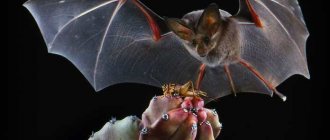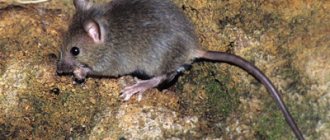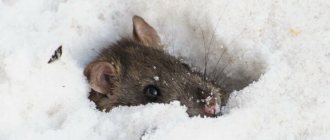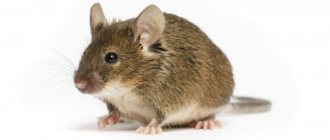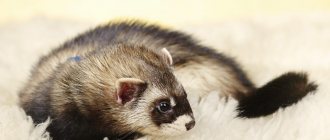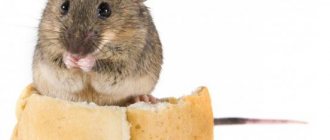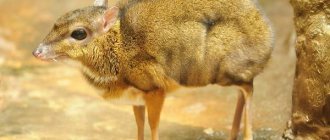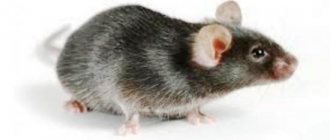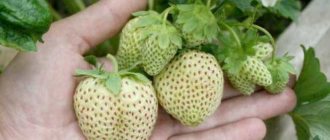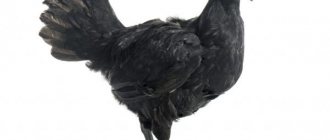The house mouse, or decorative mouse, is increasingly becoming the object of attention of people who are hesitant to buy a dog or cat. These are absolutely unpretentious animals with good adaptive qualities. They quickly become attached to their owners and never show aggression.
However, caring for pet mice has its own nuances. Therefore, before getting such a pet, it is recommended to learn more about the types, nature and features of caring for these rodents.
Care and maintenance of mice at home
The house where decorative mice live can be a cage, an aquarium, or a transparent plastic box.
For a small number of animals, a dwelling measuring 25*45*22 cm is sufficient. The bottom of the terrarium is covered with sawdust from fruit trees or hygienic filling made from corn, paper, or straw. Decorative rodents need to change their bedding at least once a week, but preferably every 3 days. The top of the terrarium is covered with a lid with holes for oxygen. Several shelters are equipped inside the house, preferably at different heights. All types of mice are very active and run up to 40 km a day in their natural environment, so the terrarium should have a running wheel. You can supply water to rodents through a hanging drinking bowl or pour it into a small saucer.
A decorative mouse is an animal that easily gets cold and overheats. It is better to place the animal’s house away from the window, protect the cage from drafts and bright sunlight. The ideal temperature for these rodents is 20-22⁰С.
Is it worth getting a decorative mouse at home?
A live house mouse costs 200-300 rubles. The low price is one of the reasons why many decide to get such a pet. But before you do this, it’s worth learning about all the advantages and disadvantages of keeping a decorative rodent at home.
| pros | Minuses |
| The mouse does not take up much space, does not run around the apartment, and does not damage the owner’s property | The noises made by mice at night disturb the sleep of household members |
| Decorative rodent is undemanding to living conditions | Specific smell |
| Mice are omnivores | Low intelligence of a rodent |
| Small expenses for food and maintenance | Short lifespan |
| The decorative mouse is easy to tame and does not bite. | |
| A pet gives a lot of positive emotions |
Description of the satin mouse
The animals in question are famous for their beautiful fur color, its shine and silky soft texture to the touch. All sorts of shades - from solid to spotted. A recessive gene is responsible for the satin tint of the hairs, so for breeding, two parents of the species are taken, who are its carrier. Siamese mice of this breed with dark spots on their bodies have become very popular.
Appearance
In appearance, satins resemble ordinary mice. The muzzle is elongated, the eyes are black, and the ears are large and round. The light whiskers are straight and long, the paws are bare with light pink skin. Coat color - from classic white and black to various cream, golden, gray, brown shades. They can be plain or spotted.
Learn about the breeds and care of gerbil mice.
Main characteristics
This breed of rodent is characterized by the following biological characteristics:
- body length 7.5–10 cm;
- weight 12–28 g;
- the tail is bare without hairs, elongated, wide at the base and gradually tapers towards the tip (there are tailless representatives of the species);
- the hind legs are five-toed, the front legs are four-toed;
- ears with hairline, translucent, large, widely spaced;
- life expectancy 2-3 years.
Incisors are constantly growing and need periodic grinding. There are different types of satin mice: satin, rex and others. Belonging to the breed is determined by the fur on the belly, especially in black individuals.
Important! Satins have weak immunity and are predisposed to tumors and viral diseases.
Behavior
By nature, satins are cute, playful, friendly and inquisitive rodents that are easy to train and quickly tamed. Calm and balanced pets easily interact with people and other animals, even cats.
The greatest activity is observed at night and in the morning. During the day they like to rest in secluded corners of the cage. They recognize the owner by smell and voice, and have high intelligence. The animal cannot sleep or remain awake for a long time. The period of activity is observed 15–20 times a day and lasts from 25 minutes to 1.5 hours.
Did you know? The word “mouse” comes from the ancient Indo-European “mush”, which means “thief”.
White mouse how to care
Nowadays, no one is surprised by the presence of unusual pets. And even rodents have become something commonplace.
The presence of decorative mice, in particular the white mouse, in homes has become quite fashionable and popular.
However, before getting such an animal, it is worth getting to know the species itself, and also have at least a small idea of how to keep it at home and how to care for it.
White mouse: appearance of the species
The white mouse is a direct descendant of common house mice. As a species, it appeared about 3,500 thousand years ago. Now this is one of the most common types of rodents. They live everywhere except in permafrost regions and highlands.
The white mouse is a popular pet
For your information! Closest relatives are jerboas, hamsters, chinchillas
The white mouse was initially considered a noble and unusual animal due to its non-standard color. She was kept in houses and temples in China and Japan, as well as in Mediterranean countries.
There, the image of a white mouse was sacred: it was not just bred for aesthetic pleasure, but was even worshiped.
The adaptability and cleanliness of the animal, as well as the ability to be friendly towards representatives of its species, were noted.
animals began more than 1.5 centuries. ago, after their mass import to Europe for experimental research.
For more than a century, white mice have been used as experimental animals.
Description of the size and character of white house mice
The white mouse is one of the small representatives of rodents.
Character
Mice are active creatures. They are in constant motion. If they are not running and climbing, then they wash themselves, gnaw, and dig.
Note! They are characterized by friendliness. There have been no recorded cases of aggressive behavior towards their relatives or other small animals. They can quite easily share their food with others.
White mice behave trustingly with people. Tamed individuals recognize the owner and can take food from their hands.
You need to hold the animal in your arms carefully
In relation to their offspring, white mice are caring parents. They not only do not abandon newborn mice, but take care of them, decorate the house for their offspring, and not only females, but also males do this.
What to feed white mice at home
White mice are unpretentious in food. Despite this, it is very important to maintain a balanced diet, as with any animal.
A rodent's diet may include:
It is important to periodically add vitamin and mineral complexes to the diet to maintain and improve the animal’s health. This is especially useful and necessary for pregnant and lactating individuals.
Important! Salty, fatty, spicy, smoked and fried foods, as well as confectionery sweets, are strictly contraindicated for pets.
White mice should be fed no more than once a day. The norm is 1 teaspoon per individual. The mice are given unboiled tap or well water, but most importantly, clean water.
Features of care and maintenance of white mice at home
Caring for white mice itself is not difficult. They are quite unpretentious creatures. Animals can be tamed quite quickly. Starting from the age of one month, the mouse can already be picked up. Soon he himself will recognize the owner and go into his arms. Tamed animals are easy to train - make them perform all sorts of tricks.
Important! When breeding white mice, it is necessary to take into account that they emit a specific smell that not everyone can tolerate, especially when there are many individuals in a small area.
Much attention must be paid to the animals’ housing. The habitat of rodents must be at least 40x40 cm in size for one individual. If you plan to have a couple or three individuals, then the home should be more spacious.
You can place the animal in a cage, a special plastic box or an aquarium. It is worth paying attention that the space between the bars of the cage does not exceed 10 mm, otherwise the rodent will easily and quickly slip through the gap and get lost in the corners of the apartment.
When using an aquarium, the top must be covered with a special lid with ventilation holes or a mesh. The floor of the home must be covered with paper and sprinkled with shavings, sawdust, and hay.
Note! It is also necessary to take into account the location of the cage. Do not place the house with mice in a draft or near the heating system. The temperature in the room where animals are located should not exceed 20-22 ° C, air humidity - 50-60%.
A small container, preferably made of durable material, should be placed in the cage itself. This will create a kind of cozy mink. It is advisable to place perches or shelves for climbing and a running wheel in the mouse house. This will allow the animals to be active and not become fat in captivity.
It is better to use a feeder made of durable material. Special automatic devices in the form of glass tubes with a spout extended to the side are very convenient as drinking bowls. In addition to the main food, you can add hard bread, sticks, and twigs to the feeder, since mice have to sharpen their teeth.
Even when in captivity, mice need to move
Don’t forget to wash the rodent’s house with water and change the bedding in it more often.
Important! You should not place mice of the opposite sex in the same cage unless you plan to breed rodents. These animals are capable of constant and uncontrolled reproduction.
Don’t forget that mice are nocturnal animals, but over time they can adapt to a person’s routine. These rodents sleep on average about 10 hours a day.
Mice, like other living creatures, are susceptible to diseases. The most common among them are such serious diseases as tumors, cystitis, parasitic infections, otitis media, smallpox, salmonellosis, etc. If you suspect a problem, you should immediately contact a veterinarian.
In Russia, white mice are often kept as pets. Sections and clubs for lovers of these decorative rodents are being created. Despite the specific smell, the animal is popular among breeders because it is unpretentious in keeping and feeding. Their curiosity and friendliness are also valued.
Source
white mice: their housing
If you want to know more about the life of house mice in nature, about their friends and enemies, then click here: House mice in nature
white mice: their housing
Before purchasing this animal, prepare an “apartment” for it in advance, but caring for white mice is simple and accessible even to a child (Read more about this: House (white) mice: nutrition and maintenance)
The animals do not require any special premises or special care. In nature, mice observe a hierarchy and live in clearly organized communities, occupying their area from several square meters, sometimes up to several hundred. At the same time, they mark the boundaries of the site with their urine.
Are nasal drops safe during pregnancy?
Is it possible to use drops for a runny nose during pregnancy? There is a classification of rhinitis. Each type requires special treatment and an integrated approach. The reasons during the period of bearing a child are:
Viral diseases requiring immediate medical intervention. The risk of infection entering the baby’s body and amniotic fluid increases. The consequences of the pathology will be unfavorable.
- Hormonal imbalances cause vasomotor rhinitis. The cause is increased secretion of progesterone and estrogen, which provokes an imbalance of hormones, leading to a weakening of the body's defenses, thinning of the mucous membrane, swelling and hyperemia. The woman’s immune system ceases to resist pathogenic microflora. Its task is the physiologically correct formation of embryonic tissues and organs of the baby. Vasomotor (hormonal) rhinitis lasts several months. Hypoxia caused by its presence leads to a slowdown in fetal development and the formation of embryonic anomalies.
- Allergic manifestations with nasal discharge and swelling pose a serious problem for the immune system of the woman and the fetus. An allergist will identify the irritating factor after conducting a series of tests. Will select an effective nasal drug approved for use by the expectant mother.
With caution, doctors prescribe medications to women who have a tendency to increase blood pressure. The use of vasoconstrictor compounds leads to the development of a hypertensive crisis, which adversely affects the baby’s health.
Correctly selected nasal drops relieve symptoms and hypoxia. The treatment is effective and the risk of adverse effects is minimal.
Features of behavior
Decorative mice are an ideal pet for those people who cannot spend a lot of time at home and pay a lot of attention to them. These rodents are completely unpretentious in care, that is, you don’t need to walk with them, there is no need for education and training, they don’t need a lot of space - they live perfectly within the confines of their own cage.
It is very interesting to watch them - each mouse has its own character and its own manner of behavior, which manifests itself in games and in interaction with a person or with relatives. Mice are quite active creatures. They love to play and also easily adapt to new conditions, such as moving to a different house or cage. Despite the fact that they are nocturnal, they are quiet and do not disturb anyone.
It is rare for mice to bite their owners, but this can happen due to fundamentally improper handling of the animal. If you are bitten, you must get vaccinated and change your behavior towards the mouse.
Size and character
In size, snow-white mice are not very different from their relatives. They weigh from 18 to 30 grams. The body length is up to 11 centimeters, the tail length is from 5 to 11 centimeters.
They are very active, climbing all the time. In addition, they are absolutely non-aggressive and easily find a common language with their relatives and owners.
If you want to get several of these mice at once, then there is no need to worry about their behavior and buy several cages. They get along peacefully, share food and resolve issues of dominance without the use of force. But they need to be placed in a cage together and preferably at an early age. If a newcomer is added to an already existing group that has been living together for a long time, the residents will definitely begin to pursue him, especially if it is a male. Such persecution often leads to the death of a stranger.
But one individual is also of interest for its habits: it easily makes contact, trusts its owner, happily runs towards an outstretched hand, waiting for the next dose of affection or food.
Don't forget that these rodents are good parents. After the birth of the cubs, not only the mother, but also the father takes care of them; together they build a nest and take care of the offspring, surpassing almost all domestic pets in their “family” nature.
What to feed a mouse
Ornamental mice feed mainly on grain mixtures, including seeds of herbaceous plants such as wheat, oats, peas, barley, cake, millet, sunflower seeds, and flax. Can be supplemented with nuts.
Oilseeds should be present in an amount of no more than twenty percent of the mixture in summer and thirty in winter, otherwise the risk of obesity is high. Too much legume seeds can also lead to obesity, although their presence in the diet is desirable. Mice can be pampered with berries, fruits, especially apples, dried fruits, carrots, cabbage, potatoes, beets and cucumbers. In addition to all of the above, feeding mice porridge is common. Oatmeal, rice and millet porridge are suitable
It is important that the porridge is cool and contains grains that have been previously cleared of impurities
It is vital for mice to have their incisors ground down from time to time. Small branches of trees and shrubs are well suited for this purpose, the main thing is that they contain bark. Almost all plants are suitable for this, except lilacs and conifers.
If preparing food yourself is difficult, then pet stores sell ready-made mixtures and other nutritional components for mice.
Mouse behavior and temperament
Mice are nocturnal and very social, so it is best to keep them in groups. Ideally, get a couple of females. If the cage size allows, you can create a larger group.
Pairs of males should be avoided unless they are related. Unfamiliar males are more likely to fight. If you have a male and a female, then soon you will have to care for their offspring.
Most mice become tame over time, be patient and maybe treat them with treats. Give the mice time to get used to their new environment. Once the mice have calmed down, spend more time near their cage and talk to them quietly to get them used to your voice.
Gradually they will get used to your hands and will not be afraid to sit on them.
When you try to pick up the mouse, try to “scoop” it by cupping your hand underneath it, but do not squeeze or grab your pet's body. If you come across a mouse with a temper, try holding the base of its tail with one hand so that it does not jump off and hurt itself.
If you are going to let her go for a walk outside the cage, do it in such a way that you don’t have to look for something missing later.
What are rodents?
Of all mammals, the order of rodents is the most numerous. They live on almost all continents of our planet. They are absent only in Antarctica and on some oceanic islands.
Animals can differ from each other in every possible way in size, color, shape of the head and other parts of the body, as well as the thickness of the fur. The main common difference for all types of rodents is a pair of large long incisors at the bottom and top. These teeth grow throughout life, gradually grinding down on solid food. Another characteristic feature is diastema - the gap (in place of fangs) between the incisors and the remaining teeth.
Animals inhabit steppes and forests, mountainous areas, river valleys and deserts. They can lead an underground and semi-aquatic lifestyle, and some have even mastered the air (flying squirrels). Rodents feed mainly on plant foods, but some species eat insects, worms, small vertebrates and other animals.
Care
Caring for an unpretentious animal is not difficult, you just need to follow the rules of hygiene and feeding. However, these things should be taken seriously. Rodents, especially decorative ones, are susceptible to various kinds of diseases. Their diet should be balanced and the food fresh.
What to feed
Due to its physical characteristics, the rat is an omnivore: it happily eats meat and vegetable dishes, cereals and porridges.
To maintain the balance of minerals and vitamins in feeding, you need both boiled porridge and raw cereals:
- buckwheat;
- corn;
- rice;
- wheat;
- barley.
Sprouted grains, seeds, and nuts are welcome. Good digestion will be ensured by the consumption of fermented milk products, especially since rodents love them. The animals love and eat meat and fish, offal and boiled eggs. Vegetables and fruits are necessary as a source of vitamins and organic acids, but in moderation.
You cannot feed the following foods:
- chocolate;
- raw vegetables - cabbage, potatoes, spinach;
- sweets;
- spicy, salty, smoked, fried;
- alcohol;
- soda.
Important! There is no need to worry about the amount of food - rodents have a developed sense of fullness, and they never eat more than they need.
Hygiene and bathing
Proper care that will ensure a long and healthy life for your pet includes a clean home.
The cage requires daily cleaning:
- washing dishes;
- changing water (it should always be fresh);
- replacing the filler and cleaning the tray.
The cage should be washed with any disinfectant twice a week. Hygienic procedures are also necessary for the animal. It is not necessary to wash it yourself - just provide a container with soapy water, and the pet will wash itself. Rats naturally love water: they swim, dive and even hunt well there.
Rat breeders have many different opinions about trimming claws, pros and cons. If we think logically: in nature, an animal grinds its claws down almost every day - on stones and trees. But sitting at home in a cage or running around on the sofa, it is impossible to do this. To prevent claws from growing into the pads, causing pain to your pet, it is advisable to purchase miniature nippers or scissors. It is recommended to check with your veterinarian how often and how to carry out the procedure correctly.
Video: bathing rats
Possible diseases and their prevention
Domestic rodents do not come into contact with street animals that can carry infections and bacteria. Typically, tame animals have a well-developed immune system, so health problems can only be hereditary, or acquired as a result of errors in care.
Important! Each genotype has its own predisposition - for example, megacolon (an abnormality of the large intestine) is hereditary in Blazes.
Factors provoking diseases:
- improper diet;
- poor quality products;
- lack of hygiene (personal and indoor);
- drafts, cold or heat, high humidity.
These errors in caring for your pet can cause the following diseases:
- Teaser's disease (an acute infection characteristic of rodents);
- pseudotuberculosis;
- pneumonia;
- pituitary tumor;
- tail necrosis;
- pneumococcosis.
Rarely, mycoplasma infections occur as a result of the spread of the pathogen in the sales environment or in the breeder. Therefore, a newly acquired animal needs to be quarantined for some time. Within 7–10 days, you need to observe your behavior and health status.
Also read about why your pet rat itches.
Among the preventive measures:
- purchasing an animal from trusted breeders;
- a well-designed diet that excludes prohibited foods;
- kept in a dry, moderately warm place, without drafts;
- exclusion of stressful situations.
At the first examination, you can get competent advice from a rodentologist on the conditions of keeping the rodent. Vaccination will help eliminate health problems. The specialist will select a vaccine against diseases needed according to the animal’s belonging to a particular species.
How to train and play with your pet
It is not difficult to train a rat: from the first days of communication, it recognizes its owner and willingly makes contact. Playing with a candy wrapper on a string or climbing a rope - in general, everything that requires movement gives her pleasure. During such fun, the rodent learns to trust the owner and remembers repeated gestures or sounds.
Video: how to train a rat
A smart baby quickly remembers his name and responds to it. The animal easily masters commands: bring an object, jump over an obstacle and many other tricks. The main thing is to focus on a certain action, for example, then give out a treat.
Did you know? During research, scientists from the Chinese University of Hong Kong discovered a gene in rats that protects the body from sexually transmitted diseases.
Interesting facts about mice
The following facts demonstrate how amazing house mice are:
- Contrary to popular belief, these decorative rodents love sweets and lard, not cheese, but eating such food is harmful.
- The mouse genome is almost 80% identical to the human genome.
- Each mouse family has its own unique smell, thanks to which rodents determine their own membership in a particular group.
- House mice have very good hearing, but poor eyesight. They perceive sounds with frequencies up to 100 kHz.
- In a stressful situation, the mouse secretes a substance with a pungent odor along with its urine. It warns relatives of danger. When other rodents sense it, they become afraid and run away.
Interesting Facts
Most people consider mice to be primitive creatures.
But the interesting facts about mice, which are given below, refute this opinion:
- Mice reach sexual maturity in the second or third month of life. This is due to the fact that rodents have a large number of natural enemies; early sexual maturity contributes to rapid population growth.
- The smallest representatives of the mouse subfamily are called baby mice. The body weight of a newborn individual is only one gram.
- A common misconception that is fundamentally wrong is that mice love cheese. Rodents may only consider cheese as food if there are no other options. When there is food abundance, animals will choose sweets and fruits.
- The genetic makeup of members of the mouse family is eighty percent identical to that of humans.
- Mice have acute hearing, which allows them to detect danger in a timely manner.
- Scientists purposefully bred two types of mice for laboratory research: white and colored. These varieties do not require certain maintenance conditions, are unpretentious, and have a wide diet, which makes them easier to care for.
- Bats are recognized as the only mammal species with the ability to fly.
- Mice have a high level of intelligence. People who keep these cute rodents at home often note that their pets can learn simple tricks and respond to their nickname.
- Residents of Asian countries believe that the absence of mice at home is a dangerous sign interpreting the approach of trouble.
When choosing a mouse for home keeping, you need to remember that the rodent also needs attention, care, and affection.
Varieties
There are different breeds of decorative mice. These include:
Micromys minutus (translated as “little mouse”) is the smallest mammal in Europe. The size of this rodent reaches 13 centimeters, and the tail and body are approximately the same length. The color of the back - from red to brown - is clearly distinguished from the color of the abdomen - white or light gray. They have a very mobile and grasping tail. The muzzle of these rodents, unlike their relatives, is shortened.
Gerbils. The second most popular breed, after baby mice. They are very similar to chipmunks because they have a body large enough for mice and a short drooping tail.
Spiny rodents. These mice look a little like hedgehogs. This is all because of their fur - it is shaped like needles. This breed is difficult to confuse with others, mainly because of the coat, but not only because of it. These mice also have very unusual ears and large black shiny eyes that look like beads.
How are mice different from other rodents?
If we conduct a detailed description of mice, it is important to note that they have excellent hearing, allowing them to pick up sounds of various tones. To do this, they use ears that are rounded in shape.
On the small pointed muzzle you can notice the presence of antennae called vibrissae. Thanks to this important organ, mice are able to navigate perfectly, even in the dark. However, they do not have pouches behind their cheeks.
Most species of mice do not like to climb trees, however, they easily move on the basis of grass stems growing in meadows. And also for this they use reeds or small branches of bushes.Among them, the smallest individual was identified; it was named “baby”, since it has a body size of only 5 cm.
Kinds
The mouse subfamily includes about three hundred species, each of which is characterized by external and behavioral features. Despite significant differences, most species have a number of similar characteristics.
Types of mice, typical features, and brief characteristics of the species are given below.
African mice
Unlike most of their relatives, African mice, whose homeland is called Tunisia, are not synanthropic species and are practically not tamed.
The body length of such a mouse is no more than twelve centimeters. The color is interesting: light brown or sandy fur has several dark longitudinal stripes. Rodents do not have a pleasant odor, which sets them apart from representatives of most other species.
The typical habitat of African rodents are burrows dug in the sand or nests made in dry grass. Their food is cereals, fruits, insects, and larvae.
The natural lifespan is about four years, but in the wild rodents can live no more than a year, due to the large number of natural enemies.
Grass mice
Grass mice live on the African continent. The body size of representatives of this species ranges from ten to seventeen centimeters.
Rodents prefer to settle in humid environments, for example, along the banks of rivers and lakes. Grass mice can build houses on their own, using dry grass, fluff, and also occupy other people's homes.
Lesnaya
A distinctive feature of wood mice is a small spot on the chest that has a yellowish tint.
These rodents are common in areas with temperate climates. Rotten stumps, dry grass, tree roots, and other voids of natural origin can serve as housing for them. Wood mice feed on cereals, insects, and berries.
Yellow-throated mouse
The yellow-necked mouse is classified as a poorly studied species listed in the Red Book.
The decline in the population of this species is due to the specific habitat; these tiny rodents, whose body length is no more than ten centimeters, live exclusively in deciduous forests.
Gerbil
The gerbil mouse fully lives up to its name, as it lives in hot deserts, semi-deserts, and steppes.
This breed of mice is distinguished by the presence of a long fluffy tail, which tends to fall off when in danger. A new one does not grow back. The diet of gerbils consists of cereals, insects, seeds, fruits, and nuts.
Gerbils can jump long distances and move on their hind legs. These rodents lead an active lifestyle during the daytime. In winter they do not hibernate, but become lethargic and inactive.
Gerbils are light brown in color, with the fur on their bellies being several shades lighter.
Harvest mouse
The field mouse lives in areas with temperate climatic conditions. The shades of the rodent's fur can vary from light brown to black; there is a longitudinal contrasting stripe on the back.
The body size of the animal is no more than ten centimeters. Mice of this species can live in urban areas. Their food sources are cereals, invertebrates, insects, fruits, and nuts.
House mouse
House mice are called synanthropic species of rodents that live close to human habitation, feed on food supplies, and prefer to spend the winter in houses and apartments.
The size of the rodent varies from eight to five centimeters. They are unpretentious to external conditions and nutrition. Life expectancy is about two years, but in good conditions the rodent can live up to four years.
Shrew
The shrew is a type of mouse that digs and also has a long, thin nose. The coat color of these animals is uniform and can vary from gray to black.
Shrews feel especially good near natural bodies of water.
Bathing rules
Rats should be bathed in warm water. This is best done using shampoo. Sometimes a small brush can be used as a washcloth. Rat claws are often trimmed before or after bathing.
It is imperative to bathe the rat if it is smeared with something. It’s not so scary if it’s food, but if it’s something inedible, then while cleaning itself, the rat can simply get poisoned. Sometimes it is enough to simply wash the rat's paws and tail. Bathing is also recommended if the rat smells bad. Most often this is due to untimely cleaning of the cage.
Pet rats are quite shy, so bathing can be stressful for them. It is best to lower the rat into a container and pour water into it so that it can stand with its paws on the bottom. First you need to wet the rodent's fur, and then apply shampoo. Baby shampoo is quite suitable for bathing. You need to make sure that the product does not get into your eyes and ears.
It is necessary to dry the rodent by wrapping it in several towels
If a pet lives with other rodents, then it must be introduced into the cage carefully, since a different smell may cause rejection of its fellows. If the rat is healthy, then you need to bathe it once a month (if it is a female), or combine this with wet wipes (if it is a male)
Content
In terms of keeping the mouse, it does not require thorough attention and the selection of special food. Plus, the cost of maintaining these pets is quite low .
This decorative rodent from the white mouse family is very easy to train. Once the mouse gets used to its owner, it will not hesitate to come to its owner's arms. When letting a mouse go for a walk from its cage, it is better to keep an eye on it with both eyes. Because if she hides somewhere, then finding her will be a difficult task.
Types of mice
The mouse family is very large. Scientists count 4 subfamilies and 147 genera. And there are even more species - 701. But the most common are those species that have coexisted with humans for thousands of years. These include:
- Field mouse or vole. This rodent is medium in size by mouse standards. The length of its body can reach 12.5 cm. The fur on the back of the rodent is predominantly gray. In some individuals it may have a slight yellowish-brown tint and a dark longitudinal stripe. The fur on the belly is also gray, but of a lighter shade. Voles live in meadows, bushes, gardens and parks. They live in burrows and bushes. In the latter case, they independently build nests between the branches. The diet of voles includes berries, grains, green parts of plants and insects. People have been trying for a long time and unsuccessfully to reduce the number of this species of mice.
- Yellow-throated mouse. The coat of this rodent on the back is reddish-gray in color, and on the abdomen and neck it has a yellowish tint. The body length does not exceed 13 cm. Moreover, the length of the tail is almost equal to the length of the body. This mouse weighs approximately 50 g. The yellow-throated mouse prefers to settle in rocky areas, on the edges of forests and in burrows. They are able to feed on both plants and bugs and worms. If necessary, they can eat meat. These rodents pose a serious threat to fruit tree orchards.
- Grass mouse. This is a very large rodent by mouse standards. The length of its body can reach 19 cm. Add here the length of the tail and you get a total length of 35 cm. Individual representatives of grass mice can weigh up to 100 g. The fur on their back is dark gray. It is not uniform, but has interspersed individual stiff and darker bristles. The fur on the belly is uniform and has a light gray tint. This rodent is most common in African countries. It feeds mainly on plants and grains.
- Tiny mouse. These are one of the smallest representatives of the mouse kingdom. The body length of an adult does not exceed 7 cm. Such a baby weighs no more than 10 g. The fur on its sides and back is reddish-brown, and on its tummy it is almost white. Unlike larger mice, the little mouse's muzzle is short and blunt. The ears are small and almost round. You can meet this animal in forests, steppes and meadows. This rodent loves to settle in haystacks and dig holes near human habitation, because food can always be found there. The diet of baby mice is based on cereals and small insects. People consider these rodents to be one of the main pests in agriculture.
- House mouse. Without exaggeration, this type of rodent can be called the most widespread on our planet. The body of an adult can reach a length of 9.5 cm. The weight does not exceed 30 g. The fur on the sides and back is gray. On the belly, its color can range from light gray to white. The rodent's muzzle is pointed. This type of mouse can be found in almost all human outbuildings. Rodents chew everything they can get their hands on.
- Striped mouse. This rodent has an average body size of 10 cm. The fur is predominantly gray. May have stripes of lighter shades. This type of rodent is often kept as pets. Moreover, in natural conditions they live no longer than 7 months, and in captivity their life span increases several times. This rodent prefers to eat grass and small insects.
- Spiny mouse. This rodent is found quite often. You can recognize him by his huge eyes and ears like mugs. Instead of the usual fur, very small needles grow on the sides and back of this mouse. This rodent has amazing regeneration abilities and uses them in encounters with enemies: it sheds part of its skin and runs away. Such animals are often kept at home as pets.
The familiar white mouse
The white mouse has long been known as a pet. Its existence was noted before our era, approximately 3500 years ago. The first information comes from the east, from countries such as China and Japan, although many continue to believe that the appearance of these rodents was provoked by the efforts of scientists to conduct various experiments and experiments.
In ancient times, mice were kept in monasteries and temples as sacred animals and were cultivated. A manifestation of this can be considered the fact that among many eastern peoples the first month of the calendar is named in her honor, although in some countries the mouse image was replaced with a rat one.
Some believed that these mammals could bring happiness. In Japan, there was a widespread belief that if you keep a white mouse in your home, it will rid the house of the attacks of its wild counterparts. In turn, astrologers in Ancient China used these rodents to make predictions.
But it was not only in the east that mice were cultured. Even if it was not whites, but brownies, they were revered in Ancient Greece. The image of a mouse was inextricably linked with the cult of Apollo, who was often depicted with a mouse sitting at his feet.
In some regions of Greece, Apollo was considered the patron saint of these rodents, and therefore they were kept in temples.
In other regions, he was considered a god who protected the homes of his admirers from the damage that these animals bring and from mouse invasions. There was even a myth about this.
Mass breeding of these animals began at the end of the 19th century, when the first batch of these rodents was imported to Europe for the purpose of scientific research. At the moment, they have become an indispensable resource for carrying out various experiments and the need for them does not fade over time.
What to feed a white mouse at home?
What does a white mouse eat at home? Its diet, like that of any rodent, must be balanced. A white mouse eats about 50 grams of food per day. This quantity may include the following components:
- Grains from crops such as oats, wheat, rye and rice.
- Vegetables (cabbage, carrots, lettuce).
- Cottage cheese.
- It is useful to sometimes feed them with stalks of green grass.
- Fruits such as pears and apples will also benefit them.
- Sometimes pets can be pampered with seeds.
- Legumes should be given in limited quantities.
- Pregnant females and nursing mothers should be fed vitamin supplements and fish oil.
- Animal feed should be added at least once a week. This can be any invertebrates and sometimes raw meat.
- Spicy foods, as well as fatty or fried foods, should not be given.
- It is not permissible to feed rodents candy.
When wondering what an animal eats at home, you also need to think about the dosage of food. Of course, these pets are not aggressive and share food peacefully, but it is still better that they do not lack it.
For example, if we talk about animal food, then it is worth allocating three insects for each rodent.
By following these simple recommendations, you won’t have to worry about what to feed your white mouse to keep your pet healthy.
Of course, you can come across a wide variety of food on the Internet, but it is worth remembering that choosing a diet without chemical additives is much safer for your pet. Therefore, we do not recommend trusting advertising pictures with the inscription “food for white mice,” even with colorful photos.
We can sum it up by saying that these animals do not require much effort to maintain their vital functions at home. You just have to arrange their home, feed them properly and change the bedding. For this, the animal will thank you with its attention and curiosity.
How mice behave in their natural environment
In order for rodents to maintain a constant body temperature, they need to be active in winter and summer, day and night. Gluttony and fussiness for mice are characteristic traits that help them survive and leave offspring.
In the fall, animals begin collecting provisions in a burrow or on the surface of the ground, where the “warehouse” is camouflaged with earth. And if in the off-season rodents are awake at night and sleep during the day, then in winter they remain active around the clock. In spring and autumn, when there is no shortage of food and no temperature fluctuations, mice actively reproduce.
Mice live in large families, since together it is easier for them to defend themselves, get food, build homes, and raise offspring. In a mouse pack there is a leader who maintains order in the group. Female mice are peaceful. But young males do not always put up with their subordinate position. Stomping with its hind legs and aggressive tail strikes indicate the animal’s intention to conquer the “throne.” Inter-family clashes can lead to the disintegration of the pack.
General characteristics of mouse representatives
The mouse family is diverse. Mice are omnivores and herbivores. Some were bred artificially so that they could be kept as pets. Habitat: all continents. The only place on the planet where mice are not found is Antarctica and mountain slopes.
Distinctive features of the appearance of mice are:
- length up to 10 cm (rare species up to 12 cm);
- fur along the entire length of the body;
- triangular muzzle;
- The ears are round, large, sticking out in different directions.
It is impossible to confuse mice with other rodents, since their size is too small. The color of the animal is varied, and only albinos have red eyes. The rest of the breeds have small black eyes.
All types of mice are fertile. Throughout the year, a sexually mature female brings up to 8–10 litters. But life expectancy does not exceed 5 years. Each litter contains from 5 to 8 mice. The duration of gestation is 21 days.
Young mice are born blind, without fur. Over the course of 14–21 days, the pups become similar to adults, but smaller in size. Completely independent, they get their own food.
Interesting fact! Reproduction activity occurs in the summer due to a sufficient amount of food. In autumn the animal is less active. In winter, the female is able to give birth only once.
